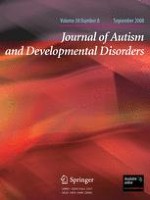01-09-2008 | Original Paper
Sensory Sensitivities and Performance on Sensory Perceptual Tasks in High-functioning Individuals with Autism
Gepubliceerd in: Journal of Autism and Developmental Disorders | Uitgave 8/2008
Log in om toegang te krijgenAbstract
Most reports of sensory symptoms in autism are second hand or observational, and there is little evidence of a neurological basis. Sixty individuals with high-functioning autism and 61 matched typical participants were administered a sensory questionnaire and neuropsychological tests of elementary and higher cortical sensory perception. Thirty-two percent of autism participants endorsed more sensory sensitivity items than any control participants. Both groups made few errors on elementary sensory perception items. Controls made few errors on higher cortical sensory perception items, but 30% of the autism participants made high numbers of errors. These findings support the common occurrence of sensory symptoms in high functioning autism based on first person report, and the presence of neurological abnormalities in higher cortical sensory perception.
